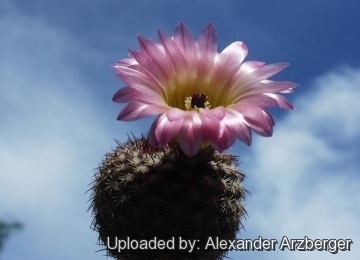Accepted Scientific Name: Parodia mueller-melchersii (Backeb.) N.P.Taylor
Bradleya 5: 93. 1987

Parodia rutilans Photo by: Alexander Arzberger
Origin and Habitat: Parodia rutilansSN|17651]]SN|17651]] occurs in the Sierra Largo, from near the Brazilian border of Uruguay.
Synonyms:
See all synonyms of Parodia mueller-melchersii
Common Names include:
ENGLISH: Pink ball cactus
Description: Parodia rutilansSN|17651]]SN|17651]], best known as Notocactus rutilansSN|17657]]SN|17657]], is a small-growing, usually solitary, cactus species. The numerous stiff, sharp spines are varicoloured and the centrals are reddish-brown. The flowers are very showy, 5 cm long, with much white wool along the tubes, and translucent petals, salmon to carmine-red shading to egg-yolk yellow in the centre. The plants are very free-flowering and self- fertile; producing many seeds. When in flower the whole plant shimmers with color and it flowers when quite young. Two subspecies of Parodia rutilansSN|17651]]SN|17651]] are sometime recognized the nominate form (dull green with 2 central spines) and Subspecies veeniana (bright green with 1 central spine).
Derivation of specific name: The Latin epithet 'rutilans', 'reddish-orange', presumably refers to the the colour of the spination.
Stems: Globose, to slightly elongate or shortly cylindrical in age, dull bluish green to bright green, to 5 cm high.
Ribs: 18-24, running spirally and divided by deep furrows, with small chinlike humps.
Areoles: Densely white woolly, later less so.
Central spines: 1 or 2, light reddish brown, straight or pointing slightly downward, lower one stoutest, to 7 mm long.
Radial spines: 14-16, diverging, white to yellowish or gray, with darker tips, to 5 mm long.
Flowers: Salmon, rose or carmine red, with dark tips, buttercup yellow inside, throat paler, 3-4 cm long, to 6 cm in diameter. Pericarpels and floral tubes with white wool and reddish brown bristles.
Fruits: Up to 1.5 cm long.
Subspecies, varieties, forms and cultivars of plants belonging to the Parodia mueller-melchersii group
 Notocactus mueller-melchersii var. eugeniae (Vliet) N.Gerloff & Neduchal
Notocactus mueller-melchersii var. eugeniae (Vliet) N.Gerloff & Neduchal- Parodia mueller-melchersii (Backeb.) N.P.Taylor: (Subsp. mueller-melchersii) has about 22 ribs, 1-3 central spines, 15-18 radials, and golden yellow flowers. Distribution: Sierra de los Animos, Uruguay.
- Parodia mueller-melchersii subs. gutierrezii (W.R.Abraham) Hofacker: has 22-24 ribs, 1 central spine, 12-16 radials, and reddish flowers. distribution: Rio Grande do Sul, Brazil.
 Parodia mueller-melchersii subs. winkleri (Vliet) Hofacker: has 20 ribs, one central spine, as many as 12 radials, and citron yellow flowers. Distribution:Tacuarembo, Uruguay.
Parodia mueller-melchersii subs. winkleri (Vliet) Hofacker: has 20 ribs, one central spine, as many as 12 radials, and citron yellow flowers. Distribution:Tacuarembo, Uruguay. Parodia rutilans (Däniker & Krainz) N.P.Taylor: It is usually dull green in color and has 2 central spines. Distribution: Sierra Largo in Rio Grande do Sul, Brazil.
Parodia rutilans (Däniker & Krainz) N.P.Taylor: It is usually dull green in color and has 2 central spines. Distribution: Sierra Largo in Rio Grande do Sul, Brazil.- Parodia rutilans subs. veeniana (Vliet) Hofacker: has usually bright green stems and has 1 central spine. Distribution: Tacuarembo.
Bibliography: Major references and further lectures
1) Edward Anderson “The Cactus family” Timber Press, Incorporated, 2001
2) James Cullen, Sabina G. Knees, H. Suzanne Cubey "The European Garden Flora Flowering Plants: A Manual for the Identification of Plants Cultivated in Europe, Both Out-of-Doors and Under Glass" Cambridge University Press, 11/Aug/2011
3) David R Hunt; Nigel P Taylor; Graham Charles; International Cactaceae Systematics Group. "The New Cactus Lexicon" dh books, 2006
4) N. L. Britton, I. N. Rose “The Cactaceae: Descriptions and Illustrations of Plants of the Cactus Family,” Volume 3 1922.
5) Krainz, Hans (Hrsg.) “Die Kakteen” 1957-1975 Franckh'sche Verlagshandlung
6) Hans Hecht “BLV-Handbuch der Kakteen” BLV-Verlagsgesellschaft, 1982
7) Haustein, Erik. “Der Kosmos-Kakteenführer.” Kosmos / Gesellschaft der Naturfreunde., Stuttgart, 1983
8) The Cactus and Succulent Journal of Great Britain, Volume 41 Cactus & Succulent Society of Great Britain., 1979
9) Urs Eggli, Leonard E. Newton “Etymological Dictionary of Succulent Plant Names” Springer Science & Business Media, 29 June 2013
10) Walther Haage “Cacti as House Plants” Studio Vista, 1965
 Parodia rutilans Photo by: Diego Armentano
Parodia rutilans Photo by: Diego Armentano Parodia rutilans Photo by: Alexander Arzberger
Parodia rutilans Photo by: Alexander ArzbergerCultivation and Propagation: It is easy to grow. It prefers a neutral to slightly acidic mineral-based potting mix with plenty of extra grit and feed during the summer. It likes a warm bright location, does great in partial shade but doesn't like full, hot blazing sun in the central summer month. Can support quite some water during the growing season but pot plants in winter are wet-sensitive and needs to be kept dry (rots easily if soil is wet and cold) tends to lose its roots in winter. Water Best if watered with rain water. Usually it is recommended to over-winter this plant in a bright and warm greenhouse with at least 8-10° C and rather dry (it tends to lose its roots and to rot if the substrate is wet and cold) but it has proved to tolerate temperatures as low as -5° C for short periods.
Propagation: Seeds.












